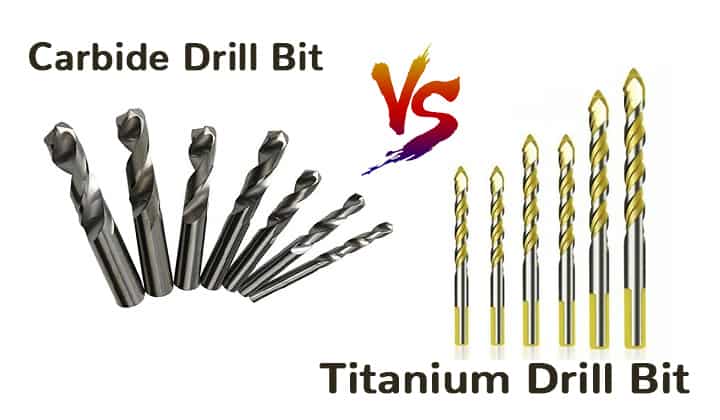I love creating free content full of tips for my readers, you. I don't accept paid sponsorships, my opinion is my own, but if you find my recommendations helpful and you end up buying something you like through one of my links, I could earn a commission at no extra cost to you. Learn more
Looking for the differences between a titanium drill bit and a carbide drill bit? At this time, titanium and carbide drill bits are two of the most commonly used drill bits in a drill machine. We sometimes think that both are for the same use, but they are quite different in reality.

In this post we'll cover:
Overview of Carbide and Titanium Drill Bit
There are many shapes, designs, and sizes in drill bits. You can get various materials and coatings too. Accordingly, it would be best to have a specific drill bit for each tooling or machining operation. Their types or patterns affirm the task where you can use them. Three primary materials are used to make a drill bit. They are High-Speed Steel (HSS), Cobalt (HSCO), and Carbide (Carb). High-Speed Steel is usually used for soft elements like plastic, wood, mild steel, etc. People buy it at a low budget for simple drilling operations. If we talk about titanium drill bit, it is actually titanium coating on an HSS. There are three types of titanium coatings available at present- Titanium Nitride (TiN), Titanium Carbonitride (TiCN), and Titanium Aluminum Nitride (TiAlN). TiN is the most popular among them. It is gold in color and runs faster than uncoated drill machines. TiCN is blue or grey. It works excellent on more rigid materials like aluminum, cast iron, stainless steel, etc. Lastly, the violet-colored TiALN is not used for aluminum. You can use TiALN in titanium, nickel-based materials, and high-alloy carbon steels. Cobalt bit is harder than HSS as it has a mixture of both cobalt and steel. People prefer it for little hard tasks like drilling stainless steel. The Carbide drill bit is broadly used for production drilling. High-quality equipment is mandatory for production drilling, and you need a tool holder to keep the equipment as well as your carbide drill bit safe. Though you can use a carbide bit in the hardest materials, it can be broken easily because of its brittleness.Major Differences of Carbide and Titanium Drill Bit
Cost
Titanium drill bits are usually cheaper than carbide drill bits. You can get a titanium-coated bit at around $8 price. Though carbide is more expensive than the titanium drill bit, it is very cheap in comparison to other options for masonry use.Constitution
The Carbide drill bit is a mixture of the hardest but fragile material, whereas the titanium drill bit is mainly made of steel coated with titanium carbonitride or titanium nitride. There is also an upgrade available from titanium nitride to titanium aluminum nitride, which multiples the tool’s life span. The exciting thing is that the titanium drill bit is not actually made of titanium if we exclude the coating.Hardness
Carbide is a lot harder than titanium. Titanium scored 6 on the Mohs scale of mineral hardness, where carbide scored 9. You cannot use Carbide (Carb) in hand drills and drill presses for its hardness. Even titanium-coated HSS (High-Speed Steel) is weaker than carbide-tipped steel.Scrape-Resistance
Carbide is more scratch-resistant because of its hardness. It is not easy to scratch a carbide bit without using a diamond! So, titanium has no match for carbide when it comes to scraping resistance.Break-Resistance
Carbide is naturally less break-resistant than titanium. You can break a carbide drill bit easily by hitting it to a hard surface because of its extreme hardness. If you work a lot with your hands, titanium is always a better option for its break resistance.Heaviness
You know that carbide has a big mass and density. It weighs twice as much as steel. On the other hand, titanium is highly lightweight, and a titanium-coated steel bit is undoubtedly much less weighty than carbide.Color
The Carbide drill bit typically comes with grey, silver, or black color. But, the titanium drill bit is simply identifiable for its golden, blue-gray, or violet look. Anyway, you will find silver steel inside the titanium coating. A black version of the titanium bit is available nowadays.Conclusion
The prices of both drill bits vary based on different retailers. Each and every customer deserves access to the same high-quality drill bit with the same price range. Therefore, you should compare the prices of carbide drill bits and titanium drill bits in several retailers to ensure that you don’t overpay. In their respective fields, both products have authenticity. Thus, use the above information to match your needs and preferences, and choose the best option.I'm Joost Nusselder, the founder of Tools Doctor, content marketer, and dad. I love trying out new equipment, and together with my team I've been creating in-depth blog articles since 2016 to help loyal readers with tools & crafting tips.
